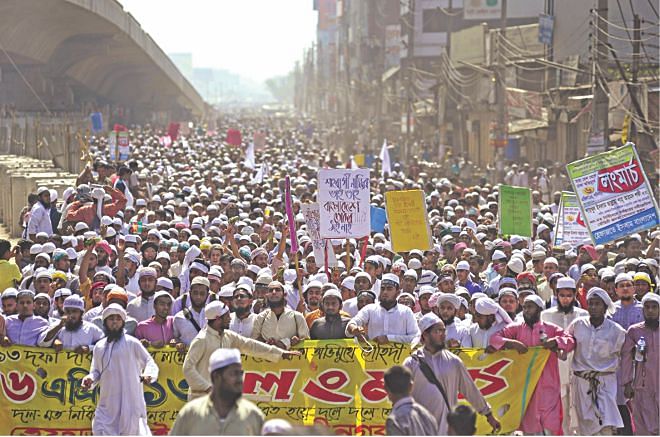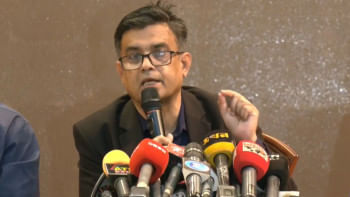Hefajat-e-Islam is coming to town, again!

THE clock is ticking. Hefajat-e-Islam is coming to Dhaka on December 24. As I write this article, the horrors of the day-long seige of Hefajat-e-Islam on May 6 followed by its occupation of the country's financial hub, burning, looting and vandalizing of private and public properties, and then their ejection by law the enforcement agencies are still fresh in our mind. The Motijheel seige ended in a bloody showdown, exact death toll still remains a matter of controversy and conjecture. Since then, of course violence has become part of our lives.
The repeated political impasse between the two major parties had resulted in the rise of political violence and poor governance which in turn created space for the extremist religious forces to grow in the country.
During the period 1999–2005, we saw the rise of outfits like Jamaatul Mujahedin Bangladesh (JMB), Harkat-ul-Jihad al-Islami, Bangladesh (HUJI-B) that adopted terrorism as a means to establish an Islamic state in Bangladesh. During these years, Islamist forces grew in strength, often with official cover and patronage provided by the party in power.
The BNP-Jamaat government initially denied the existence of these terrorist forces, but as the terrorist activities grew in intensity and frequency, there was rising international pressure on the government to take action against those forces. The government then came down heavily and by 2007, after a few death sentences and long term imprisonment of the key figures, the JMB, HUJI-B forces apparently went out of the radar screen. It was revealed during investigation and prosecution that most of the JMB and HUJI-B activists came from Qawmi madrasas, traditional Islamic religious schools, thousands of which had sprang up across the country, uncontrolled and unaccounted for. However, it was considered a taboo to blame the madrasas, and their education system that produced the terrorists, lest it hurts the feeling of the ordinary Muslims who continued to support the madrasa education as an act of piety. The rise of Hefajat once again has brought the Qawmi Madrasa system into focus.
The AL government came to power in 2009 with a manifesto that included education reform, including reforming madrasa education. While a number of positive steps were taken to improve the general education system in the country, virtually nothing was done in the field of Qawmi madrasa education. The government's attempt to register the Qawmi madrasas and to open them to government inspection and supervision was resisted by the Madrasa authorities.
The exact figure of Qawmi madrasas is not known. It is estimated that about 15-20% of the school-age youth of Bangladesh are now educated in Qawmi madrasas. It all started in the early 1980s with the patronage of then President General Ershad, who adopted 'Islamisation' of the society as tool of convenience. Setting up mosques and madrasas across the country was one such measure.
Unfortunately, the elected BNP and AL governments that followed Ershad's fall from power continued to allow unbridled growth of madrasas as a policy of appeasement of the Islamist forces.
Most of the Qawmi madrasas follow a syllabus and text books prescribed by Darul Uloom, Deoband, a madrassa in UP, India, set up in 1866. These madrasas are also called Deobandi Madrasa. The madrasas generally follow a 17th century syllabus known as Darse Nizami that emphasizes on Islamic Sharia of Sunni tradition. When these students graduate from Qawmi madrasas, they are not only unprepared to face the challenges of the modern world, but have a very narrow view of Islam as a religion.
The government, in its effort to appease the madrasa lobby and especially to neutralize the Hefajatis, recently declared setting up an Arabic University and a Qawmi Education Board, but the effort was abandoned due to stiff opposition from the Deobandi groups.
The rise of the Hefajat took all of us by surprise, but it is now evident that they had been organizing for a long time. The Hefajat-e-Islam emerged from Darul Uloom Muinul Islam Madrasa in remote Hathazari, near Chittagong.
We scoffed at the Hefajati threat until when they reached the outskirts of Dhaka on May 5 and the streets were packed with thousands upon thousands of white turbaned madrasa students. We had to revisit the Hefajat's 13-point demand to ascertain what these people stand for. The demands included: declaring Bangladesh an Islamic state, imposition of Sharia law, death penalty for apostasy, declaring Ahmedia community as non-Muslims, seclusion of women from public life, breaking down of architectural heritage which the Hefajatis described as idols etc. These demands are all in common with the Talibans of Pakistan and Afghanistan. The Talibans destroyed thousand year old historic statues; they routinely destroy female schools on the plea that women need no modern education; they force the girls into Burqa and ban them from public life and employment. It is ironic that taking advantage of the political chaos and poor governance, an obscurantist organization such as Hefajat-e-Islam could flourish in Bangladesh and threaten the very ideological foundation of the country.
That the Hefajatis are a potent political force has been proven in the last five city corporation elections. BNP, which is a centre-right political party, took full advantage of the Hefajatis to play the Islamist card. They were able to convince a large voting population that Islam is indeed in danger in Bangladesh with Awami League in power. It is possible that with the combined support of the Hefajat-e-Islam and Jamaat-e-Islami, BNP could sweep the next election, when and if it happens. However, the problem will start soon thereafter when BNP will try to put the genie back into the bottle. The Islamist forces by then will be calling shots and BNP will have to give in to many of the demands of the Islamists.
Time is indeed running out for us to prepare against the emerging threat poised at our gate ready to destroy our gains of independence and freedom. The best way to fight religious extremism and terrorism is to create a broad and common platform of the democratic forces and not to allow the extremist forces exploit the political vacuum. A common front against all form of religious extremism could be our best defence. The question is, “Are we ready?”
The writer is registrar, Brac University.

 For all latest news, follow The Daily Star's Google News channel.
For all latest news, follow The Daily Star's Google News channel. 



Comments